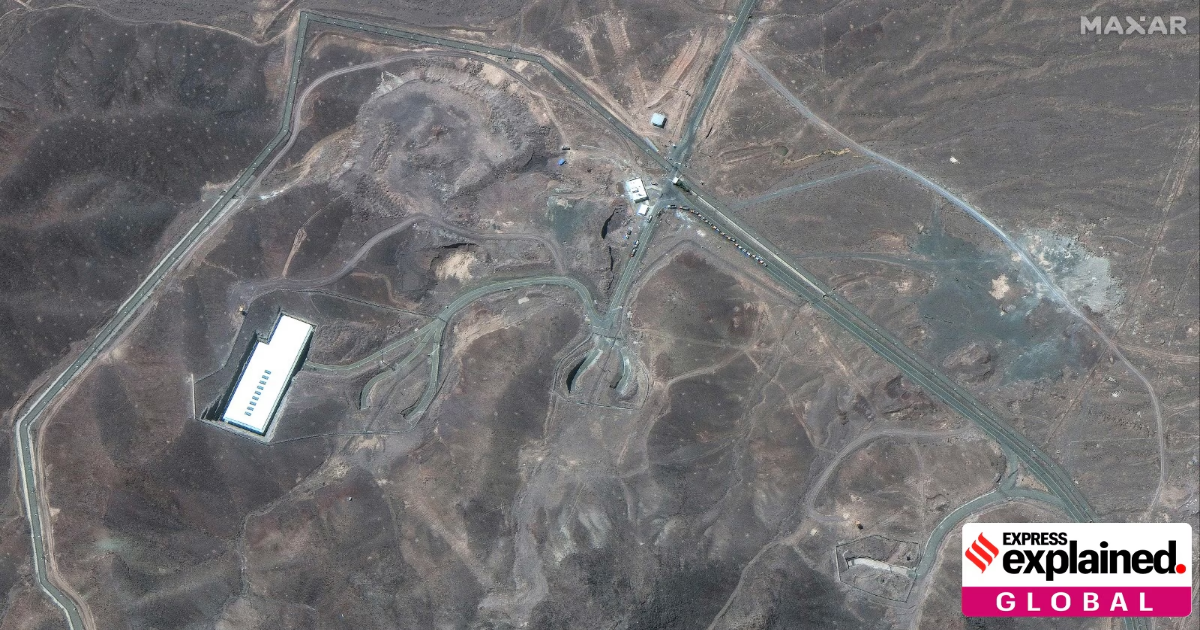The Atomic Energy Organization of Iran confirmed the attacks.
Here’s what we know so far about the US strikes on Iran
Story continues below this ad
The nuclear sites attacked and how important they are in Iran’s nuclear programme
The US attacked three key nuclear sites of Iran — Natanz, Isfahan and Fordow — as it joined Israel in its offensive against Iran. All the three sites are crucial to Iran’s controversial nuclear programme that the US, Israel and many other countries see as a threat.
Natanz: Located about 220 km southeast of Tehran, Natanz is Iran’s main enrichment site that had Uranium enriched up to 60% purity before Israeli strikes destroyed a part of this facility, according to the UN’s nuclear watchdog International Atomic Energy Agency (IAEA). The purity standard matches to a mildly radioactive level but just a small step away from weapons’ grade. Another part of the facility on Iran’s Central Plateau is positioned underground to keep it safe from potential airstrikes and operates groups of centrifuges working together to enrich uranium more quickly.
Fordow: Buried under a mountain about 100 km southwest of Tehran and guarded by anti-aircraft batteries, Fordow nuclear facility looks to be designed to ward off airstrikes. However, this is not as big as Natanz. According to IAEA, Iran had begun its construction at least in 2007 but informed the UN in 2009 only after the US and allied Western intelligence agencies became aware of its existence. According to military experts, it could be targeted only by “bunker buster” bombs — a term for bombs that can penetrate deep below the ground level before exploding. These are the bombs the US used in the recent strike.
Isfahan: Isfahan facility is situated some 350 km southeast of Tehran and houses three Chinese research reactors and laboratories linked to Iran’s atomic programme. Thousands of nuclear scientists work here.
What bombs did US use to strike Iran?
The US forces used six B-2 bombers to drop 12 bunker-buster bombs on Fordow, reported CNN. Navy submarines fired 30 Tomahawk cruise missiles at Natanz and Isfahan, while a B2 dropped two bunker busters on Natanz, a US official told CNN.
These B-2 stealth bombers are equipped with the GBU-57 Massive Ordnance Penetrator, a 30,000-pound bunker-buster bomb designed to dismantle heavily fortified underground targets. This type of bomb is unique to the US arsenal and is considered the only weapon capable of effectively targeting Iran’s most protected nuclear facilities.
Why has the US attacked Iran now?
The US has for long opposed Iran possessing a nuclear weapon and was in talks with the country to strike a nuclear deal when Israel attacked Iran on June 13, triggering retaliation from Iran. Though Iran has maintained that its nuclear programme is solely for peaceful purposes, Trump and Israeli leaders believed Iran could potentially assemble a nuclear weapon, making it a looming threat.
Last week, the IAEA Board of Governors censured Iran for the first time in 20 years for not working with its inspectors. It happened amid talks between the US and Iran for the removal of economic sanctions on Iran in exchange for reducing or ending uranium enrichment.
The stalemate in the nuclear talks prompted Trump to issue a statement last week cautioning Iran that it cannot have a nuclear weapon and that it should have signed the nuclear “deal” with America.
Iran also maintained that it would not discuss the future course of its nuclear programme while at war with Israel.
With the Israel-Iran offensive underway, Trump on Thursday said Iran will be granted two weeks to enter into substantial negotiations before attacking. However, the two weeks were cut short to two days as the US attacked Iran’s facilities on Saturday night.
How Iran reacted
Iran’s Foreign Minister Abbas Araghchi termed the US strikes on Iran a “grave violation” of the international law, UN Charter, and the Treaty on the Non-Proliferation of Nuclear Weapons. Warning of “everlasting” consequences of the “outrageous” events, Araghchi said: “Each and every member of the UN must be alarmed over this extremely dangerous, lawless and criminal behavior. In accordance with the UN Charter and its provisions allowing a legitimate response in self-defense, Iran reserves all options to defend its sovereignty, interest, and people.”
What Trump said on any possible retaliation
Trump said that any retaliation by Iran against the strikes by US will be met with force “far greater than what was witnessed” on Saturday night.
What Israel has said
Israeli Prime Minister Benjamin Netanyahu hailed Trump’s move to attack Iran’s nuclear sites. In a video message addressed to the American President, Netanyahu said: “Your bold decision to target Iran’s nuclear facilities, with the awesome and righteous might of the United States, will change history,” he said. Netanyahu said the US “has done what no other country on earth could do”.
Following the attack, Israel announced closure of the country’s airspace to both inbound and outbound flights.
Is the US attack a violation of Trump’s election promise?
On the campaign trail in the run up to 2025 US elections, Trump had slammed past administrations for engaging in “stupid endless wars” in the Middle East and promised to keep America out of conflicts among foreign powers. The US’s decision to enter as a third party in the Israel-Iran conflict is hence being seen as a ‘promise not kept’.
